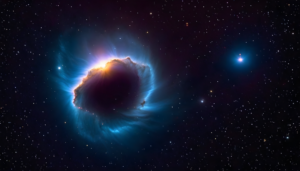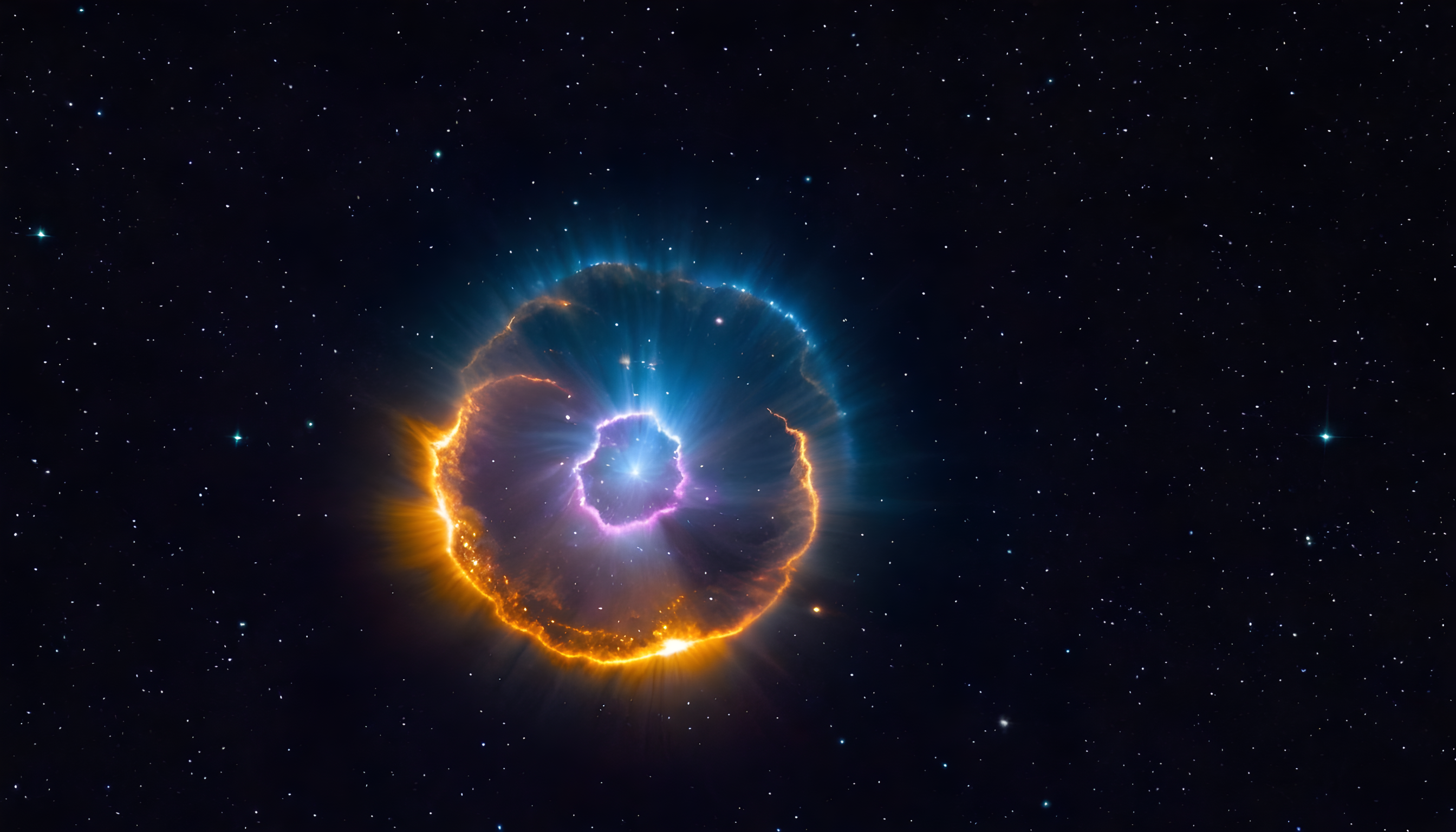Supernova: The Universe’s Most Brilliant Explosions
Supernovae, awe-inspiring detonations originating from the demise of massive stars, emerge as some of the cosmos’s most enthralling and formidable events. These colossal explosions, with their intense brilliance, momentarily outshine entire galaxies, unleashing a torrent of elemental materials that hold the potential to give rise to thousands of nascent stars and planets, shaping the intricate tapestry of cosmic landscapes. As celestial phenomena of unparalleled magnificence, supernovae not only captivate our imagination but also contribute significantly to the perpetual cycle of creation and destruction that defines the ever-evolving cosmos.

The Cosmic Crucible: Supernova
In the celestial theater, stars undergo a seemingly tranquil process as they harmoniously fuse hydrogen into helium at their cores. This intricate dance generates immense heat and pressure, forming a delicate equilibrium that counteracts the gravitational forces vying for their collapse. However, for stars boasting approximately eight times the mass of our sun, a distinct and dramatic fate begins to unfold.
As these stellar giants gradually deplete their hydrogen fuel reserves, a transformative narrative takes shape within their cores. The ceaseless pull of gravity, once held at bay by the counteractive forces of fusion, now asserts its dominance. The gravitational collapse becomes an unstoppable force, heralding the commencement of a celestial spectacle known as a supernova. This pivotal moment in a star’s lifecycle marks not only its demise but also the birth of cosmic phenomena that reverberate through the vast expanses of the universe.
The Stellar Symphony of Implosion and Explosion: Unveiling the Phenomenon of Supernova
In the cosmic ballet of celestial events, the dramatic process of a supernova unfolds with intricate precision. As a massive star nears the end of its life, the gravitational forces at its core lead to a cataclysmic collapse. Within this cosmic crucible, temperatures and densities surge to astronomical extremes, propelling the fusion of heavier elements such as carbon and oxygen.
This sudden release of energy momentarily halts the relentless collapse, offering a fleeting reprieve before the inexorable forces at play resume their gravitational dance. The star’s core continues its inexorable journey, compressing further until it reaches a critical juncture. At this pivotal moment, a spectacular astronomical rebound occurs, unleashing an unimaginable force—the breathtaking birth of a supernova.
In this cosmic spectacle, the interplay of implosion and explosion paints a vivid portrait of the universe’s inherent dynamism. The mechanisms driving the formation of a supernova not only captivate astronomers but also offer a glimpse into the fundamental processes that shape the fabric of our cosmos. As we delve into the complexities of this stellar phenomenon, we uncover the cosmic symphony that accompanies the grand finale of massive stars, illuminating the profound beauty and intensity inherent in the life cycle of the cosmos.
Diverse Supernova Types: Supernova
- Core-collapse supernovae: Within the cosmic theater, supernovae unveil a fascinating narrative, presenting diverse tales of celestial demise. Core-collapse supernovae, born from the cataclysmic fate of massive stars, orchestrate explosive finales that yield the birth of neutron stars. In the most colossal scenarios, these colossal explosions forge the mysterious and gravitational enigmas known as black holes.
- Thermonuclear supernovae: Conversely, thermonuclear supernovae, unfolding within the remnants of stars akin to our sun—white dwarfs—paint a different cosmic canvas. These stellar remnants, fueled by carbon cores, become the stage for runaway nuclear fusion, sparking spectacular explosions that transcend the celestial realm.
As we peer into the vastness of the cosmos, the intricate tapestry of supernova diversity unfolds, revealing not just the celestial fireworks of cosmic annihilation but also the profound stories of stellar evolution and transformation. Each type of supernova contributes a unique chapter to the cosmic chronicle, enriching our understanding of the celestial drama that plays out in the vast expanse of the universe.
The Cosmic Impact of Supernovae:
Supernovae, far from being mere celestial pyrotechnics, assume pivotal roles in shaping the intricate tapestry of the universe’s evolution. The elements expelled during these awe-inspiring explosions, ranging from essential components like iron to precious metals like gold, intricately enrich the interstellar medium. This process becomes the fertile ground for the genesis of future stars and the formation of planetary bodies. Beyond their role as cosmic alchemists, supernovae also act as dynamic catalysts for star formation. By compressing the surrounding gases and dust through their powerful shockwaves, these cosmic explosions stimulate the birth of new stellar entities, contributing to the perpetually unfolding narrative of the cosmos. In essence, supernovae stand as cosmic artisans, shaping the raw materials of the universe and orchestrating the grand symphony of creation on a scale that transcends the bounds of human imagination.
Recent Cosmic Fireworks: Supernova
- The Celestial Spectacle of SN 2023A: In the cosmic theater, a recent discovery, SN 2023A, has graced the stage, captivating astronomers and stargazers alike. Unveiled in January 2023, this supernova, situated a relatively close 200 million light-years away, beckons scientists with a unique opportunity for an up-close examination. Positioned within our cosmic neighborhood, SN 2023A promises to provide astronomers with an intimate view, enabling them to peel back the layers of mystery surrounding these celestial detonations and gain deeper insights into the intricate workings of the cosmos.
- Connecting the Dots: Supernovae and Fast Radio Bursts (FRBs): In a fascinating twist, recent cosmic investigations have unearthed connections between the cosmic ballet of supernovae and the enigmatic phenomena of Fast Radio Bursts (FRBs). These millisecond-duration radio bursts, known for their elusive nature, are now thought to be linked to the aftermath of supernovae. The emerging hypothesis posits that the powerful shockwaves generated by these stellar explosions might serve as triggers for the occurrence of FRBs. This newfound association adds a layer of complexity to our understanding of both supernovae and FRBs, creating a compelling narrative that intertwines the fates of these cosmic phenomena. As astronomers delve into the intricacies of SN 2023A and explore the potential ties to FRBs, the cosmic stage becomes a vibrant arena for unraveling the celestial mysteries that continue to captivate the imagination of those who gaze at the night sky.
Unlocking Secrets Through Observation: Supernova
Astronomers, armed with a diverse arsenal of telescopes and sophisticated instruments, embark on an intricate journey to dissect the secrets concealed within supernovae. Optical telescopes diligently capture the radiant display of visible light emitted during the explosive event, providing a vivid snapshot of the supernova’s brilliance. Simultaneously, the deployment of advanced radio and X-ray telescopes serves to unveil distinct facets of this cosmic phenomenon, enriching our understanding of its multifaceted nature.
In the meticulous scrutiny of supernovae, scientists not only witness the breathtaking spectacle of celestial explosions but also glean profound insights into the intricate life cycles of stars, the evolutionary dynamics shaping galaxies, and the fundamental composition of the vast universe itself. This relentless pursuit of observation transforms supernovae into cosmic laboratories, where the unfolding narratives of celestial events offer a window into the cosmic tapestry, unraveling the mysteries that govern the grandeur of the cosmos.
Supernovae: A Symphony of Cosmic Power and Beauty:
In the vast cosmic tapestry, the phenomenon of supernovae unfolds as a breathtaking symphony, orchestrating a display of immense power and unparalleled beauty. These celestial eruptions, akin to cosmic fireworks on an unimaginable scale, serve as vivid reminders that our universe is not a static entity but a dynamic and ever-changing realm. Within this cosmic ballet, supernovae stand as radiant beacons, illuminating the cosmic canvas with awe-inspiring wonders and sparking an insatiable curiosity about the tantalizing mysteries that lie scattered throughout the cosmos.
Further Exploration:
- NASA: Supernova Exploration
- Space.com: Supernova Overview
- National Geographic: Cosmic Adventures
